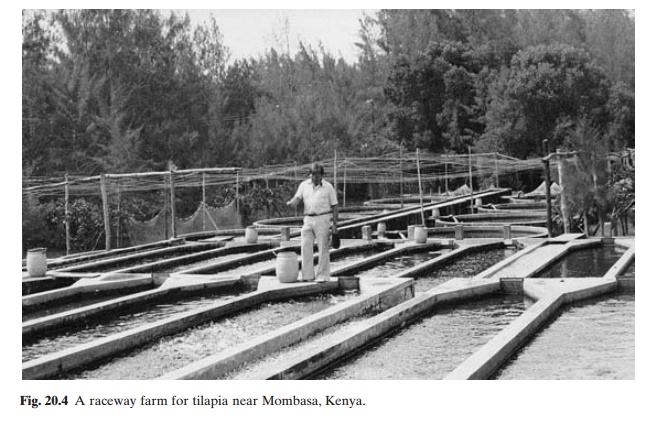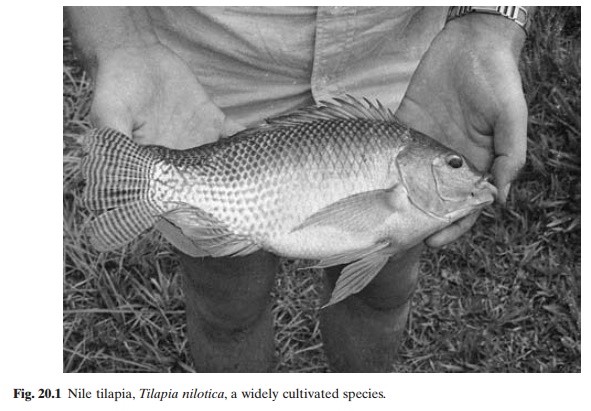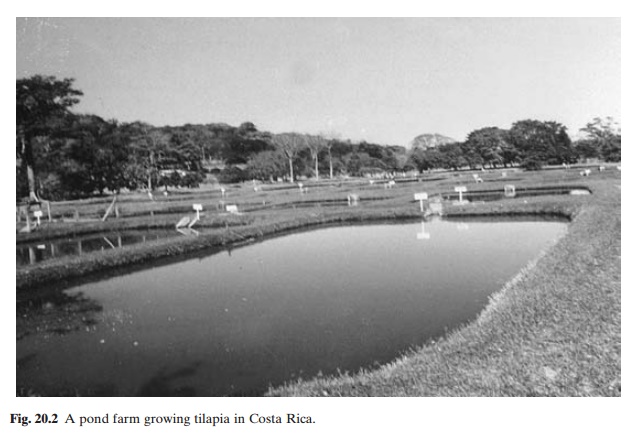Chapter: Aquaculture Principles and Practices: Tilapias
Culture systems of tilapias

Culture systems
Tilapias are euryhaline and grow well in brackish and salt waters. T. mossambica
and T. zillii can grow even in hypersaline waters above 42 ppt. The hybrid
red tilapia seem to grow best in brackish- and sea-water environments. Species
like T. aurea and T. zillii do not appear to breed in high
salinities, but T. mossambica reproduce at a salinity as
high as 49ppt (Popper and Lichatovich, 1975).

The most common and widely practised system of culture of tilapia is in
earthen ponds and similar impoundments (fig. 20.2). As the species can survive
in a restricted space, all sizes of ponds have been used, including those
measuring less than 100 m2. In pond culture, attempts have been made to control overpopulation by
stocking a certain number of predators (2–10 per cent of the stock), such as Hemichromisfasciatus, Lates niloticus, Clarias lazera, Micropterus
salmoides, Channa striata and Cichla ocellaris. In brackish- and
salt-water ponds, Elops hawaiensis and Dicentrarchus spp. have beenused as
predators. In order to reduce breeding and increase production, mono-sex
culture of males is carried out in a number of tilapia farms. The techniques of
separating the sexes, or producing mono-sex stocks by hybridization or by
sex-reversal, have not been perfected to the extent necessary to ensure the
complete absence of female fish. A few female fish in the ponds can cause
uncontrolled breeding.

In many areas, tilapias are produced mainly by polyculture. They have
been used as a compatible species with a number of fresh-water fish, including carps,
grey mullets, Clariaslazera, Heterotis niloticus and the
Amazoniancharacid tambaqui (Colossoma
macropomum).
Intensive monoculture of tilapia in indoor tanks is carried out in
colder climates, as in China, using warm water during the winter season. Over-wintering
of fry during the cold season and stocking in open ponds during the spring is
also a common practice in temperate regions. The economic viability of these
systems depends very much on the local market value of the species.

Cage culture of tilapia in both fresh and salt water has received
considerable attention, not only for more intensive production, but also as a
means of controlling wild spawning and over-population. Although in many areas
it is still on an experimental or pilot scale only, there are some successful
commercial operations, as for example in the Philippines and Costa Rica (fig. 20.3).
Pen culture of tilapia in open waters of lakes is practised in the Philippines.
Tank and raceway culture are also done on a very limited scale, for producing
marketable fish (fig. 20.4) or bait fish.

In some of the countries of Southeast Asia, especially in the
Philippines and Thailand, rice-field culture of tilapia is practised on an
appreciable scale. To obtain marketable fish within the short period of rice
cultivation or between crops, mono-sex culture has to be adopted. Tilapias have
also figured as important species in integrated animal and fish farming systems
in several Asian and some African countries.
Stocking in open waters has been carried out in a few countries to
enhance or develop commercial fisheries. A notable success is the development
of self-sustaining stocks in lakes and reservoirs in Sri Lanka and in Lake
Kinneret (Tiberius) in Israel. Stocking has also been undertaken in lakes or
reservoirs in East Africa (Kenya, Tanzania, Uganda, Rwanda, Zambia, Zimbabwe,
etc.) and in central Florida (USA).
Related Topics